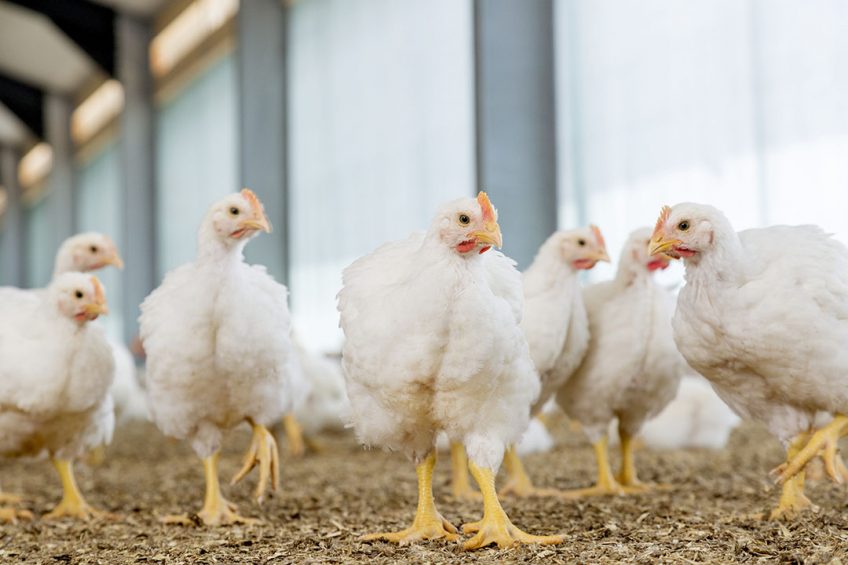Improving yellow skin pigmentation in broilers fed AGP-free

When reducing or eliminating antimicrobial growth promoters (AGP) in poultry production, producers must pay careful attention to feed, farm and health challenges.
In some regions, producers face an additional challenge: achieving skin pigmentation levels desired in the marketplace. Failing to achieve adequate levels of yellow pigmentation can result in lower value end products.
Broiler production in Mexico amounts to more than 300 million broilers per cycle and the country’s marketplace places some unique demands on its poultry farmers. Skin pigmentation is widely considered both an indicator of a bird’s health status and meat quality. As such, yellow pigmented broilers represent a significant portion of the broiler wholesale and retail market in Mexico. Broiler skin pigmentation isn’t merely a matter of appearance but also impacts economics. Price penalties may be incurred when threshold pigmentation levels are not achieved. As Mexico’s farmers continue to reduce or remove antimicrobials from their production practices, the challenge of achieving the desired yellow pigment levels can be complicated by gut health issues in flocks.
Affecting pigment absorption
Management practices, a broiler’s health status and diet composition can all interfere with pigmentation uptake and expression in broilers. Both Necrotic Enteritis (Clostridium perfringens) and coccidiosis damage the intestinal mucosa and thereby interfere with the absorption of pigments from the intestine. Beyond contributing to bird health challenges, both of these conditions can also result in broilers’ having a less than optimum skin colour, with potential economic consequences.
Mexican production practices
With the production environment, flock health challenges and pigmentation levels in mind, researchers at Trouw Nutrition collaborated with Integracion Y Desarrollo Agropecuario S.A. (INDEPESA) to evaluate the effectiveness of a gut-improving feed additive in supporting yellow skin pigmentation in broilers. The trial was conducted in a production environment using no AGPs or coccidiostats under typical Mexican rearing conditions. The findings from the trial showed that the gut-health-improving additive (Presan-FY) (containing a synergistic blend of organic acids, medium chain fatty acids (MCFAs), patented alkyl esters of MCFA’s, target release butyrates and a phenolic compound), enhanced the yellow skin pigmentation of broilers fed AGP-free diets.
 Broccoli: Antimicrobial and antioxidant benefits in broilers
Broccoli: Antimicrobial and antioxidant benefits in broilers
The feed industry is constantly seeking sustainable alternatives to antibiotics. Broccoli residues have valuable antimicrobial and antioxidant properties that make them an attractive alternative.
A total of 2,700 Ross 308 male broilers were divided into 6 treatments of 9 replicates, each with 50 birds. The treatments were arranged in a factorial 3×2 design, with the first factor being the yellow pigment level (60, 85 and 110ppm of Xantophylls). The second factor was the presence or absence of the gut-health-improving feed additive. Xantophylls (yellow pigment) and canthaxanthin (red pigment, 3ppm) were added to the grower (11-28 days) and finisher (29-46 days) phase diets.
Diets were based on yellow corn and soybean meal and adjusted to different growth phases (starter (0-10 days), grower (11-28 days) and finisher (29-46 days)) to meet the nutritional requirements of the breed. No AGP or coccidiostats were added to birds’ diets. Birds were vaccinated on the farm according to local standard practices and with a commercial live coccidiosis vaccine. In vivo skin pigmentation was measured in 27 birds per treatment at day 43 and day 46. Intestinal morphology was measured in the duodenum and the intestinal absorptive area was calculated.
Skin pigmentation can be improved
The results showed that the gut-health-improving additive significantly improved yellow skin pigmentation by 1.33 (+8.1%) and 2.92 (+16.5%) b*units when compared to birds in the negative control treatment at days 43 and 46, respectively, (p < 0.001, Figure 1). In the trial, only the gut-health-improving additive treatments achieved the highest in vivo skin yellowness at day 46 (p < 0.001, Figure 2).
Figure 1 – The results showed that the gut-health-improving additive significantly improved yellow skin pigmentation when compared to birds in the negative control treatment at days 43 and 46, respectively.

Figure 2 – Only the gut-health-improving additive treatments achieved the highest in vivo skin yellowness at day 46.

Understanding the mode of action of feed additives is essential to advancing poultry nutrition. Improvements in birds’ skin yellowness as shown in the study are presumably associated with the positive effect that the gut-improving feed additive has on gut integrity. Previous studies have shown a synergistic effect of gut-health-improving additive ingredients on improved intestinal morphology. In the Mexican trial, broilers fed the feed additive blend showed an increase in villus length and width compared to the negative control group birds. This effect led to a greater intestinal absorptive area, meaning nutrients – in this case, pigments – could be better absorbed in the bird’s gut. Intestinal morphology analysis showed that inclusion of the gut-health-improving additive significantly increased the intestinal absorptive area by 0.77mm2 (+11%) per mm2 of internal duodenal wall (Table 1). Additional research is required to understand the effects of this additive on pigment absorption.
The trial results suggest adding the gut-health-improving additive could help poultry producers lower the levels of xanthophylls (yellow pigments) from 110ppm to 85ppm while achieving similar pigment levels in broiler skin and also delivering gut health improving properties. Including the gut-health-improving additive boosts both pigment and nutrient absorption to support enhanced growth performance. The research is helping producers in Mexico meet various market demands across different production environments employing varying management practices. As with other studies completed in research centres and on commercial farms, the findings demonstrate that it is possible to meet wholesaler, retailer and consumer demands and achieve AGP-free production goals while supporting birds’ gut health and performance.
These trial findings support the importance of an integrated strategy to steer gut health. By approaching poultry production with a holistic programme which includes feed, farm and health management – and tailoring that approach to the needs of the marketplace – poultry producers can reduce their reliance on antibiotics, prevent animal disease and enhance flock performance.
Author: Yvonne van der Horst, Trouw Nutrition













